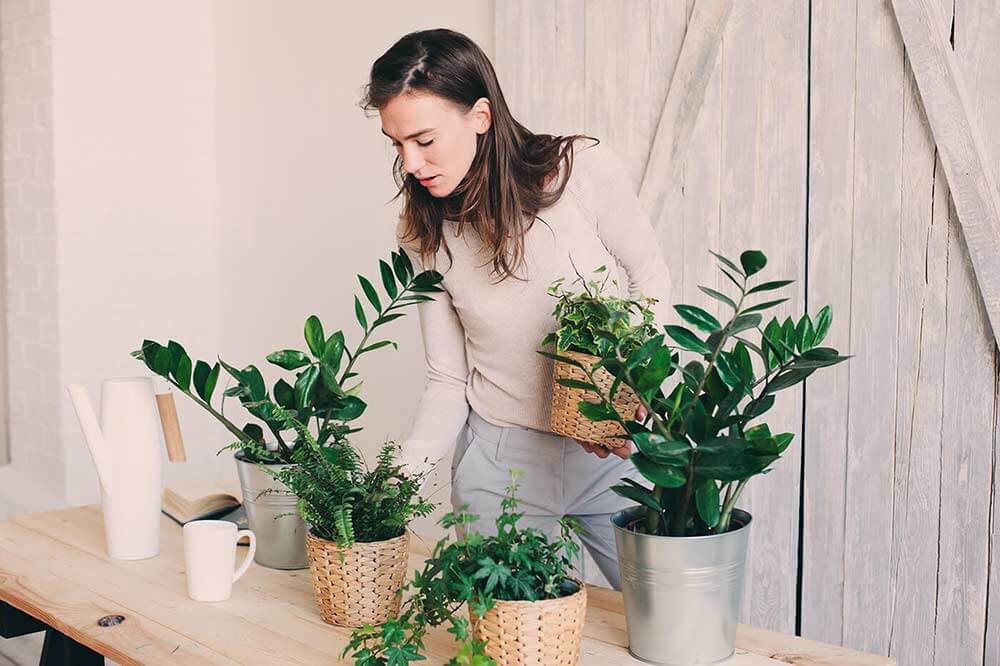
Biophilic design is a complicated-sounding name for the simple idea that looking at plants makes us happy. A growing trend in homes and workspaces even before the pandemic, the benefits of biophilic design have only become more apparent over the last year’s lockdowns. Whether a single dangling pothos on a shelf or a living room full of bird of paradise and tropical palms, greenery can improve our living and working spaces in a wide variety of ways. Here are 5 chief benefits to
1. They look great 2. They clean the air 3. They can benefit your mental health 4. You can eat them 5. They absorb sound
1. They look great
Plants get likes. Even if you’re not aware of them, the presence of plants in an Instagram photo has a huge positive impact on the power of the composition. The reason for this? It’s trendy, sure, but more importantly, after thousands of years of using plants for food, medicine, tools and shelter, humans are naturally drawn to greenery of all kinds. This means that just as a single artfully placed leaf can make the difference between an average photo and an excellent one, a plant in your living room, bedroom or office can make a big difference in your enjoyment of that space – whether you’re aware of it or not. And when we’re home as much as we have been over the past year, that makes a big difference. The great thing about plants is that they grow, and (depending on the variety) can quickly fill up a corner of a room. They’re also very easy to propagate, meaning a single aloe or spider plant can “give birth” to countless babies over its lifetime, which you can either plant yourself or give to friends as gifts.
2. They clean the air
Plants absorb carbon dioxide and release oxygen, making them not only beautiful decor pieces, but miniature air purifiers, too. NASA (among others) has done a lot of research on this, and recommend golden pothos, English ivy and bamboo palm as some of the best choices for removing carbon dioxide, along with several other airborne toxins. In addition to NASA’s picks, jade, spider plant and dracaena are also great choices for air purification.
3. They can benefit your mental health
Studies have shown that plants have a measurable positive effect on both our physical and mental health. They have even been shown to promote faster healing in hospital patients! While this link isn’t completely understood yet, there is more than enough evidence to suggest that having and caring for plants in your home and workplace can help you feel a little better every day (and who couldn’t use that?) Better still, it doesn’t seem to matter what kind of plant you choose, so everything from low-maintenance snake plants and succulents to fussier orchids and figs are all great for mind and body alike. For best results, start with something hard to kill (like the classic golden pothos) and then move on to showier and more delicate species as your plant care skills improve.
4. You can eat them
Vegetables and herbs are plants too, and there’s no reason you can’t grow these indoors all year round. If you have a bright, sunny south-facing window that’s not too drafty, start with something like rosemary, mint or chives, which do well with lots of light. If those work, there’s no reason you can’t grow tomatoes and peppers as well. If you’re working with less direct sun, you may need to invest in a UV grow light, of which there are many options on the market designed specifically for windowsill gardeners. If you’re bringing in your plant babies from the outdoors in fall, just remember to give them a thorough once-over for insects like aphids that can quickly spread to your other pots and wreak havoc on your growing plant family.
5. They absorb sound
If you’re sensitive to noise, this might be all the reason you need to add a few more leafy friends to your home or office. Much like carpeting, the soft, uneven surface of a plant’s leaves helps to break up sound waves, creating a quieter and less resonant environment. For best results, choose multiple small plants arranged around the room, as well as a few big ones, whose soil will also absorb sound. If you want to go even farther, you can create an entire green wall, which adds a unique visual element in addition to its acoustic benefits.
Jeremy Freed is a freelance writer and editor based in Toronto. His writing about fashion, travel, food and design appears in Sharp, Harry and re:Porter magazines, among many others.